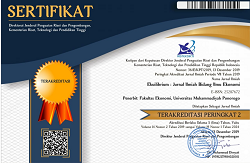Foreign Direct Investment Spillovers and Economic Growth: Evidence from Asian Emerging Countries
DOI: 10.24269/ekuilibrium.v16i1.2021.pp49-63
Abstract
Research on FDI in promoting economic growth has been the focus of recent decades, especially in developing countries. Foreign direct investment can be one of the main objectives in increasing economic growth. FDI is assumed to indirectly contribute to economic growth through a spillover effect on the absorption capacity of a country by increasing the stock of human capital and the quality of institutions. This study aims to analyze the spillover effect of FDI on economic growth in Asian emerging markets. The data were analyzed using dynamic panel regression (GMM) during 2008-2017 period with STATA 14 software.The results in this study strongly indicate that the spillovers of FDI is proven to be able to drive economic growth through human capital and institutions in Asian emerging markets.
Keywords
Economic Growth; FDI Spillovers; Human Capital; Institutions; GMM
References
- Abbas, Q., & Nasir, Z. M. (2001). Endogenous Growth and Human Capital: a Comparative Study of Pakistan and Sri Lanka. The Pakistan Development Review, 987–1007.
- Adefabi, R. (2011). Effects of FDI and Human Capital on Economic Growth in Sub-Saharan Africa. Pakistan Journal of Social Sciences, 8, 32–38. https://doi.org/10.3923/pjssci.2011.32.38
- Ahmed, E. M. (2012). Are the FDI Inflow Spillover Effects on Malaysia’s Economic Growth Input Driven? Economic Modelling, 29(4), 1498–1504. https://doi.org/10.1016/j.econmod.2012.04.010
- Ajayi, I. S. (2006). Economic Development in Africa. In ADB/AERC International Conference on Accelerating Africa’s Development Five Years into the 21st Century, 22–24. https://doi.org/10.2307/2552538
- Ali, F. A., Fiess, N., & MacDonald, R. (2010). Do Institutions Matter for Foreign Direct Investment? Open Economies Review, 21(2), 201–219. https://doi.org/10.1007/s11079-010-9170-4
- Barro, R. J, Mankiw, N. G., & Sala-i-Martin, X. (1992). Capital Mobility in Neoclassical Models of Growth. In National Bureau of Economic Research (p. (No. w4206)). https://doi.org/10.1257/aer.90.3.687
- Barro, R. J. (1991). Economic Growth in a Cross Section of Countries. The Quarterly Journal of Economics, 106(2), 407–443.
- Barro, R. J., & Lee, J. W. (2013). A New Data Set of Educational Attainment in the World, 1950-2010. Journal of Development Economics, 104, 184–198. https://doi.org/10.1016/j.jdeveco.2012.10.001
- Bekaert, G., Harvey, C. R., & Lundblad, C. (2011). Financial Openness and Productivity. World Development, 39(1), 1–19. https://doi.org/10.1016/j.worlddev.2010.06.016
- Bénassy-Quéré, A., Coupet, M., & Mayer, T. (2007). Institutional Determinants of Foreign Direct Investment. World Economy, 30(5), 764–782. https://doi.org/10.1111/j.1467-9701.2007.01022.x
- Borensztein, E., De Gregorio, J., and Lee, J. (1998). How does Foreign Direct Investment Affect Economic Growth? Journal of International Economics, 45(1), 115–135. https://doi.org/10.1111/1468-0351.00095
- Carbaugh, R. J. (2004). Economía internacional (No. 337 C3Y 1998.). Thomson.
- Cooray, A., Dutta, N., & Mallick, S. (2017). Trade Openness and Labor Force Participation in Africa: The Role of Political Institutions. Industrial Relations, 56(2), 319–350. https://doi.org/10.1111/irel.12175
- Cooray, A., Kumar, S., & Queen, M. (2011). What Explains Cross-Country Growth in South Asia ? Female Education and the Growth Effect of International Openness (No. 145; Issue June 2014).
- Cooray, A., Mallick, S., & Dutta, N. (2014). Gender-Specific Human Capital, Openness and Growth: Exploring the Linkages for South Asia. Review of Development Economics, 18(1), 107–122. https://doi.org/10.1111/rode.12072
- Daude, C., & Stein, E. (2007). The Quality of Institutions and Foreign Direct Investment. Economics and Politics, 19(3), 317–344. https://doi.org/10.1111/j.1468-0343.2007.00318.x
- De Mello Jr., L. R. (1999). Foreign Direct Investment-Led Growth: Evidence from Time Series and Panel Data. Oxford Economic Papers, 51(1), 133–151.
- Demena, B. A., & van Bergeijk, P. A. G. (2017). a Meta-Analysis of Fdi and Productivity Spillovers in Developing Countries. Journal of Economic Surveys, 31(2), 546–571. https://doi.org/10.1111/joes.12146
- Farla, K. (2014). Determinants of Firms’ Investment Behaviour: a Multilevel Approach. Applied Economics, 46(34), 4231–4241. https://doi.org/10.1080/00036846.2014.955167
- Feldstein, M. (2000). Aspects of Global Economic Integration: Outlook for the Future. NBER Working Paper (National Bureau of Economic Research), 7899, 1–15.
- Gemmell, N. (1996). Evaluating the Impacts of Human Capital Stocks and Accumulation on Economic Growth: Some NEW Evidence. Oxford Bulletin of Economics and Statistics, 58(1), 9–28. https://doi.org/10.1111/j.1468-0084.1996.mp58001002.x
- Groenewegen, J. (2004). Who should Control the Firm? Insights from New and Original Institutional Economics. Journal of Economic Issues, 38(2), 353–361. https://doi.org/10.1080/00213624.2004.11506694
- Grossman, G. M., & Helpman, E. (1991). Innovation and Growth in the Global Economy. MIT press.
- Hall, R. E., & Jones, C. I. (1999). Why do Some Countries Produce so Much More. Quarterly Journal of Economics, February, 83–116.
- Hayat, A. (2019). Foreign Direct Investments, Institutional Quality, and Economic Growth. Journal of International Trade and Economic Development, 28(5), 561–579. https://doi.org/10.1080/09638199.2018.1564064
- IMF. (2019). World Economic Outlook Update: Still Sluggish Global Growth. 9. https://www.imf.org/en/Publications/WEO/Issues/2019/07/18/WEOupdateJuly2019
- Islam, S. (1995). The Human Development Index and per Capita GDP. Applied Economics Letters, 2(5), 166–167.
- Javorcik, B. S. (2004). Does Foreign Direct Investment Increase the Productivity of Domestic Firms? in Search of Spillovers through Backward Linkages. American Economic Review, 94(3), 605–627. https://doi.org/10.1257/0002828041464605
- Kose, M. A., Prasad, E. S., & Terrones, M. E. (2009). Does Openness to International Financial Flows Raise Productivity Growth? Journal of International Money and Finance, 28(4), 554–580. https://doi.org/10.1016/j.jimonfin.2009.01.005
- Krugman, P. R., & Obstfeld, M. (2009). International Economics: Theory and Policy. Pearson Education.
- Kuo, C. C., & Yang, C. H. (2008). Knowledge Capital and Spillover on Regional Economic Growth: Evidence from China. China Economic Review, 19(4), 594–604. https://doi.org/10.1016/j.chieco.2008.06.004
- La Porta, R., Lopez-de-Silanes, F., Shleifer, A., & Vishny, R. (1999). The Quality of Government. Journal of Law, Economics, and Organization, 15(1), 222–279. https://doi.org/10.1093/jleo/15.1.222
- Li, C., & Tanna, S. (2019). The Impact of Foreign Direct Investment on Productivity: New Evidence for Developing Countries. Economic Modelling, 80, 453–466. https://doi.org/10.1016/j.econmod.2018.11.028
- Lin, C. H., Lee, C. M., & Yang, C. H. (2011). Does Foreign Direct Investment Really Enhance China’s Regional Productivity? Journal of International Trade and Economic Development, 20(6), 741–768. https://doi.org/10.1080/09638190903294866
- Liu, W. S., Agbola, F. W., & Dzator, J. A. (2016). The Impact of FDI Spillover Effects on Total Factor Productivity in the Chinese Electronic Industry: a Panel Data Analysis. Journal of the Asia Pacific Economy, 21(2), 217–234. https://doi.org/10.1080/13547860.2015.1137473
- Liu, X., & Zou, H. (2008). The Impact of Greenfield FDI and Mergers and Acquisitions on Innovation in Chinese High-Tech Industries. Journal of World Business, 43(3), 352–364. https://doi.org/10.1016/j.jwb.2007.11.004
- Lucas, R. E. (1988). World Devziopment Report. Journal of Monetary Economics, 22(February), 3–42. http://linkinghub.elsevier.com/retrieve/pii/0304393288901687
- Mankiw, N. G. (2006). Macroeconomist as a Scientist and Engineer. Journal of Economic Perspective, 20(4), 29–46. https://doi.org/10.32609/0042-8736-2009-5-86-103
- Mankiw, N. ., Romer, D., & Weil, D. N. (1992). A Contribution to the Empirics of Economic Growth. The Quarterly Journal of Economics, 107(2), 407–437. https://doi.org/10.1515/bejm-2012-0042
- Marcin, K. (2008). How does FDI Infow Affect Productivity of Domestic Firms? The Role of Horizontal and Vertical Spillovers, Absorptive Capacity and Competition. Journal of International Trade and Economic Development, 17(1), 155–173. https://doi.org/10.1080/09638190701728131
- Meyer, K. E., & Sinani, E. (2009). When and Where does Foreign Direct Investment Generate Positive Spillovers a Meta-analysis. Journal of International Business Studies, 40(7), 1075–1094. https://doi.org/10.1057/jibs.2008.111
- Muhammad, B., & Khan, S. (2019). Effect of Bilateral FDI, Energy Consumption, CO2 Emission and Capital on Economic Growth of Asia Countries. Energy Reports, 5, 1305–1315. https://doi.org/10.1016/j.egyr.2019.09.004
- Nicholson, M. (2002). Intellectual Property Rights and International Technology Transfer: The Impact of Industry Characteristics. US Federal Trade Commission, Manuscript, 2–17.
- North, D. C. (1993). Institutions and Credible Commitment. Journal of Institutional and Theoretical Economics, 149(1), 11–23. http://peintra.creatives-at-work.de/uploads/appointments/UMC4z0fuif0aLrzbJyyT/Kahnemann_New Challenges to the Rationality Assumption.pdf
- OECD. (2012). No Title. Foreign Direct Investment for Development Maximising Benefits, Minimising Costs.
- Ouyang, P., & Fu, S. (2012). Economic Growth, Local Industrial Development and Inter-Regional Spillovers from Foreign Direct Investment: Evidence from China. China Economic Review, 23(2), 445–460. https://doi.org/10.1016/j.chieco.2012.03.005
- Raza, S. A., Shah, N., & Arif, I. (2019). Relationship between FDI and Economic Growth in the Presence of Good Governance System: Evidence from OECD Countries. Global Business Review, 097215091983348. https://doi.org/10.1177/0972150919833484
- Reza, F., & Widodo, T. (2013). The Impact of Education on Economic Growth in Indonesia. Journal of Indonesian Economy and Business, 28(1), 23–44.
- Romer, P. M. (1986). Increasing Returns and Long-run Growth. Journal of Political Economy, 94(5), 1002–1037.
- Romer, P. M. (1990). Endogenous Technological Change. Journal of Political Economy, 98(5), 71–102.
- Samuelson, P. A. (2010). Economics. Tata McGraw-Hill Education.
- Schultz, T. W. (1961). Investment in Human Capital. American Economic Association, 51(5), 1035–1039.
- Self, S., & Grabowski, R. (2004). Does Education at All Levels Cause Growth? India, a Case Study. Economics of Education Review, 23(1), 47–55. https://doi.org/10.1016/S0272-7757(03)00045-1
- Shaihani, M., Harisb, A., Ismaila, N., & Saida, R. (2011). Long Run and Short Run Effects on Education Levels: Case in Malaysia. International Journal of Economics and Research, 02(06), 77–87.
- Slesman, L., Baharumshah, A. Z., & Wohar, M. E. (2015). Capital Inflows and Economic Growth: Does the Role of Institutions Matter? International Journal of Finance and Economics, 20(3), 253–275. https://doi.org/10.1002/ijfe.1514
- Solow, R. M. (1956). A Contribution to the Theory of Economic Growth. The Quarterly Journal of Economics, 70(1), 65–94.
- Sukirno, S. (2006). Ekonomi Pembangunan: Proses, Masalah, dan Dasar Kebijakan. Kencana (Prenada Media).
- Todaro, M. P., & Smith, S. C. (2006). Economic Development 8th Edition. Pearson South Asia Pte. Ltd.
- Todaro, M. P. (2002). Economic Development. Pearson Education India.
- UNCTAD. (2010). World Investment Report. Geneva: UNCTAD
- World Bank. (2019). World Development Indicators Database Online
Refbacks
- There are currently no refbacks.

This work is licensed under a Creative Commons Attribution-ShareAlike 4.0 International License.













